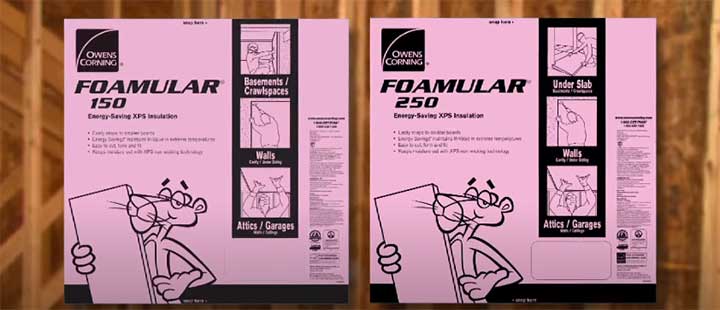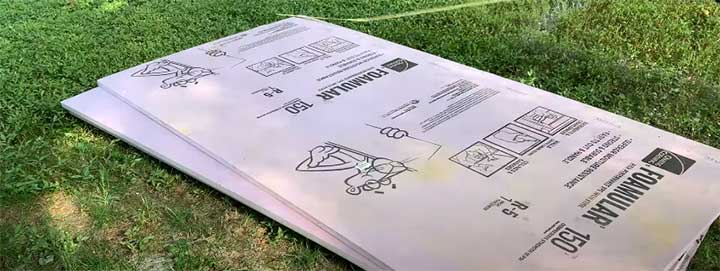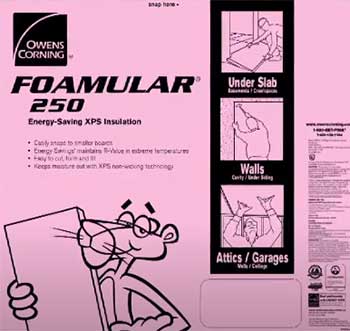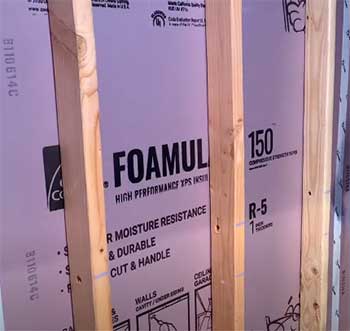When it comes to insulating your home or building project, choosing the right insulation can make a big difference in comfort, energy efficiency, and cost. Two popular options for exterior foundation insulation are FOAMULAR 150 and FOAMULAR 250 extruded polystyrene (XPS) rigid foam insulations from Owens Corning.
But what’s the difference between these two products, and how do you decide which one is right for your specific needs?
This comprehensive guide examines the pros, cons, costs, and ideal uses for FOAMULAR 150 and 250 to help you make an informed decision.
A Brief Comparison Table
| Feature | FOAMULAR 150 | FOAMULAR 250 |
|---|---|---|
| R-value per inch | R-5 | R-8 |
| Compressive strength | 15 psi | 25 psi |
| Available thicknesses | 1/4″ – 4″ | 1″ – 4″ |
| Recommended uses | Moderate climates, standard insulation apps | Cold climates, high-performance insulation |
| Color | Light blue | Bright pink |
| Moisture resistance | Excellent, water resistant | Excellent, water resistant |
| Ozone depletion potential | Zero | Zero |
| Thermal barrier required | Yes | Yes |
| Max service temperature | 165°F | 165°F |
| Dimensional stability | Excellent if installed properly | Excellent if installed properly |
Overview of FOAMULAR 150 And FOAMULAR 250

FOAMULAR 150 and FOAMULAR 250 are both types of XPS foam board insulation. XPS foam is a highly efficient, moisture-resistant rigid insulation that’s commonly used for exterior foundation and perimeter insulation.
Some key traits shared by both FOAMULAR 150 and FOAMULAR 250:
- Made from extruded polystyrene foam
- Excellent insulation R-value that resists heat flow
- Provides a continuous layer of insulation with no thermal breaks
- Lightweight yet durable rigid foam boards
- Easy to cut and install
- Water resistant and non-absorbent
- Manufactured without CFCs, HCFCs, or HFCs that can deplete the ozone layer
- Can be exposed to the elements for up to 180 days
The main difference between the two FOAMULAR products comes down to their insulation value:
- FOAMULAR 150 has an insulation R-value of 5 per inch
- FOAMULAR 250 has a higher insulation R-value of 8 per inch
The higher the R-value, the better the insulation’s ability to resist heat flow. FOAMULAR 250 has 60% higher insulating power per inch compared to FOAMULAR 150.
This means for the same thickness, FOAMULAR 250 provides significantly more insulation than 150. To achieve an equivalent total R-value, FOAMULAR 150 would need to be installed much thicker than FOAMULAR 250.
FOAMULAR 150 Insulation Overview

FOAMULAR 150 provides a basic level of highly effective insulation at a reasonable cost. With an R-value of 5 per inch, it’s suitable for most standard insulation needs.
Here are the key specs and benefits of FOAMULAR 150:
- R-value of 5 per inch of thickness
- Available in thickness from 1/4″ up to 4″
- Meets ASTM C578 Type IV requirements
- Compressive strength of 15 psi
- Dimensionally stable if properly installed
- CFC and HCFC-free with zero ozone depletion potential
- Light blue color for easy identification
FOAMULAR 150 is a lightweight, versatile XPS foam board. It’s most commonly used for:
- Exterior foundation wall insulation
- Perimeter insulation at sill plates
- Insulating rim joists in basements and crawlspaces
- Sheathing for exterior walls behind cladding
- Insulating slabs under concrete toppings
It can also be used in commercial roofing applications. The R-5 per inch value provides basic insulation for more moderate climates and regions that don’t experience extreme cold.
Some benefits of using FOAMULAR 150 insulation:
- Cost-effective – FOAMULAR 150 provides an affordable way to improve insulation. It’s more budget-friendly than higher R-value options.
- Moisture resistant – Water won’t degrade FOAMULAR 150’s insulating properties over time.
- Easy to install – Lightweight boards are simple for DIYers or contractors to cut and secure to surfaces.
- Durable – Rigid foam stands up well to job site conditions.
- Air seal – Sheets installed without gaps seal air leaks for better efficiency.
The one downside to FOAMULAR 150 is the relatively low R-5 per inch rating. For cold climates or high insulation needs, you may require using thicker boards or combining it with higher R-value insulation.
FOAMULAR 250 Insulation Overview
FOAMULAR 250 provides premium insulation with an R-value of 8 per inch, which is 60% higher than FOAMULAR 150. It’s ideal for cold climate insulation or high-performance construction.
Key attributes of FOAMULAR 250 include:

- R-value of 8 per inch
- Available in thickness from 1″ to 4″
- Meets ASTM C578 Type IV requirements
- Compressive strength of 25 psi
- Water absorption of < 0.1% by volume
- Zero ozone depletion potential
- Bright pink color for visibility
FOAMULAR 250 works well for:
- Insulating foundations and perimeter walls in cold climates
- High R-value exterior sheathing behind cladding
- Continuous insulation to eliminate thermal bridging
- Under slabs and concrete toppings
- Commercial roofing insulation
Benefits of choosing FOAMULAR 250:
- Superior R-value – Provides more insulation per inch to save energy and block heat flow.
- Thinner application – Achieves required insulation with less thickness.
- Controls moisture – Water resistant with zero capillary action to resist moisture damage.
- Higher load capacity – Can withstand compressive loads up to 25 psi.
- Withstands extreme temps – Rated for service up to 165°F.
The tradeoffs with FOAMULAR 250 are higher cost and limited thicknesses available. But for cold climate insulation or projects with demanding energy codes, the boosted R-8 per inch is often worth the extra investment.
Direct Comparison of R-values and Cost
To see the insulation performance difference between FOAMULAR 150 and FOAMULAR 250, let’s compare the R-values and material costs for various thicknesses.
- R-values for Common Thicknesses
| Thickness | FOAMULAR 150 R-value | FOAMULAR 250 R-value |
|---|---|---|
| 1 inch | R-5 | R-8 |
| 1.5 inches | R-7.5 | R-12 |
| 2 inches | R-10 | R-16 |
| 3 inches | R-15 | R-24 |
| 4 inches | R-20 | R-32 |
For the same thickness, FOAMULAR 250 consistently provides much higher insulation. To match the R-32 value of 4″ FOAMULAR 250, you would need 6″ of FOAMULAR 150.
- Material Cost Comparison
On a per board-foot basis, FOAMULAR 250 is approximately 25-30% more expensive than FOAMULAR 150. However, because you need less thickness of FOAMULAR 250 to achieve the required insulation R-value, the material cost difference is not proportional to the increased R-value.
Here’s a look at sample material prices:
| Thickness | FOAMULAR 150 | FOAMULAR 250 |
|---|---|---|
| 1 inch | $0.70/board-ft | $0.90/board-ft |
| 2 inch | $1.15/board-ft | $1.60/board-ft |
| 4 inch | $1.75/board-ft | $2.75/board-ft |
For a project requiring R-15 exterior wall insulation, FOAMULAR 150 would necessitate 3″ thickness at an estimated material cost of $1.50 per square foot. Achieving the same R-15 with FOAMULAR 250 only requires 2″ thickness for an estimated $1.25 per square foot cost.
In this example, the FOAMULAR 250 is actually cheaper than 150 while using less thickness. The material cost savings combined with potential labor savings for installing thinner insulation can make FOAMULAR 250 the more economical choice despite its higher R-value.
Recommended Uses for FOAMULAR 150 And 250
Based on their differing insulation performance and costs, FOAMULAR 150 and FOAMULAR 250 each shine in certain applications.
Here are some general guidelines for choosing which product may be preferable:
FOAMULAR 150 is a good choice when:

- You need basic insulation at the lowest cost
- Insulating moderate climates that don’t require high R-values
- Looking for budget-friendly exterior sheathing insulation
- Seeking affordable foundation perimeter insulation
- Trying to maximize coverage with limited budget
FOAMULAR 250 excels when:
- Insulating cold climate foundations and crawlspaces
- Achieving maximum energy efficiency with continuous insulation
- Adding high R-value exterior wall sheathing
- Seeking thinner insulation to save space
- Trying to meet demanding energy code R-values
- Willing to pay more for superior insulation capacity
Make sure to verify the required R-values for your particular application and climate zone when deciding between FOAMULAR products.
Here are some specific situations where choosing FOAMULAR 250 over 150 is usually advised:
- Insulating foundations and perimeter walls in northern climates. FOAMULAR 250 provides required thermal resistance more efficiently.
- High R-value exterior sheathing for walls, roofs, ceilings. FOAMULAR 250 provides better efficiency as continuous insulation.
- Insulating under concrete slabs and toppings. FOAMULAR 250 gives maximum frost protection with minimal thickness.
- Commercial roof insulation. Taller R-value meets code requirements with thinner boards.
- Passive houses or high-performance construction. FOAMULAR 250 excels for super-insulated envelope assemblies.
- Green building projects pursuing rigorous standards like LEED. High R-values qualify more easily for certifications.
If you’re unsure whether FOAMULAR 150 or 250 makes sense for your project, consulting with a qualified insulation contractor is recommended. An expert can assess your specific insulation needs and confirm which product will offer the best performance and value.
Installing and Finishing FOAMULAR Insulation
Once you’ve selected the appropriate FOAMULAR product for your application, proper installation is key to achieving the rated R-value and performance. Here are some best practices for installing FOAMULAR 150 or 250:
- Ensure a level, smooth substrate. Address any moisture issues beforehand.
- Use unfaced insulation boards rather than foil-faced. Unfaced boards provide better longevity.
- Stagger seams when installing multiple sheets. Offset boards to eliminate thermal bridging.
- Seal edges and gaps with low expansion foam. This prevents air infiltration at board joints.
- Use plastic washers on fasteners to stand insulation off surface. Allows drainage and prevents thermal bridging.
- Follow manufacturer spacing guidelines for fasteners. Typically 16-24″ for foam adhesive and 12″ for mechanical fasteners.
- Protect insulation if left exposed. Use weather resistive barrier if not covering immediately with finish materials.
For interior applications, FOAMULAR insulation must be covered with a 15-minute thermal barrier like 1/2″ gypsum wallboard. For exterior use below grade, a drainage mat and protection board should encapsulate FOAMULAR boards.
Adhering to Owens Corning’s recommended installation instructions will maintain insulation R-value and prevent moisture issues. Take care to properly seal, fasten, and protect FOAMULAR boards.
FOAMULAR Insulation Frequently Asked Questions
The main difference is the insulation R-value per inch. FOAMULAR 150 provides R-5 per inch while FOAMULAR 250 offers a higher R-value of R-8 per inch. FOAMULAR 250 has 60% greater insulating power compared to 150.
FOAMULAR 250 works well for high R-value applications like foundation insulation in cold climates, high-performance wall sheathing, and under slabs. It provides maximum insulation in less thickness.
FOAMULAR 150 offers a cost-effective insulation solution for more moderate climates. It’s commonly used for insulating perimeter walls and rim joists in basements and crawlspaces.
No, FOAMULAR extruded polystyrene insulation is dimensionally stable and maintains its R-value long-term. When installed correctly, it will deliver consistent thermal performance over the lifetime of a building.
Closing Remarks
Choosing between FOAMULAR 150 and FOAMULAR 250 insulation requires understanding your climate conditions and R-value requirements. FOAMULAR 150 provides an affordable way to enhance insulation, while FOAMULAR 250 excels for high-performance applications needing maximum R-value in less thickness.
Carefully consider your specific project goals, codes, and budget when deciding between these two FOAMULAR versions. With their moisture resistance, strength, and longevity, both options deliver outstanding rigid foam insulation.
An Owens Corning FOAMULAR product can be confidently used to boost energy savings and comfort for your building project.
